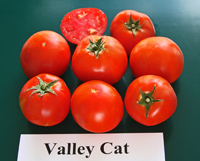|
‘ValleyCat’ tomato—the 2014 Rodeo Tomato
 "ValleyCat" tomato is the 2014 Rodeo Tomato. This tomato variety named "ValleyCat" produces a large number of large to extra-large, firm, round tomatoes. The variety produces tomatoes with outstanding fruit quality on a semi-determinate (medium size growth) plant. It is a medium maturity variety which ripens to an attractive red color with excellent interior qualities. "ValleyCat" also offers Disease Resistance: Fol: 0-1 (US1-2) / Ma, Mi, Mj / S / V (Va: 0, Vd: 0)
"ValleyCat" tomato is the 2014 Rodeo Tomato. This tomato variety named "ValleyCat" produces a large number of large to extra-large, firm, round tomatoes. The variety produces tomatoes with outstanding fruit quality on a semi-determinate (medium size growth) plant. It is a medium maturity variety which ripens to an attractive red color with excellent interior qualities. "ValleyCat" also offers Disease Resistance: Fol: 0-1 (US1-2) / Ma, Mi, Mj / S / V (Va: 0, Vd: 0)
For Growing Instructions, see:
http://plantanswers.com/Articles/KeysToGrowingVegetablesSuccessfully.asp
TABLE OF TOMATO NEMATODE AND DISEASE RESISTANCE:
Fol Fusarium wilt caused by the specified races of Fusarium oxysporum f.sp. lycopersici
Ma Ma Root knot caused by Meloidogyne arenaria
Mi Root knot caused by Meloidogyne incognita
Mj Root knot caused by Meloidogyne javanica
S Grey leaf spot caused by Stemphylium spp.
V Verticillium wilt caused by the specified race of Verticilium albo-atrum, V. dahlia
|
Have you ever wondered how some gardeners always harvest the first tomatoes of the season? In most cases these “early bird” winners are growing their plants in containers prior to setting them out in the garden or larger containers when the soil and air temperatures have warmed up enough to support tomato plant growth and fruit setting.
To "pot up" your transplants, fill a one to three gallon black plastic container with a high quality potting soil. Enrich the potting soil with a slow release fertilizer made especially for containers such as a 15-5-10 analysis or Osmocote . If an organic fertilizer is preferred, consider a 4-2-3 analysis at twice the rate. Be generous with the fertilizer; tomatoes, especially 'Dwarf Cherry Surprise', are heavy feeders if you want maximum fruit production. Since these varieties are short statured in growth, good fertility will be required to produce optimum yields. The key nutrient will be nitrogen. If adequate fertility is not maintained, the tomato bush will be small and produce much less fruit. Place the transplants in the container. They can be planted deeply; tomatoes are one of the few plants that can tolerate deep planting. Roots will form along the whole stem. This is especially important if your transplants are leggy or top heavy.
The goal of the "potting up" activity is to maintain the fast growth rate established at the nursery. Place the potted up tomato in full sun in a location out of the wind. The wind can injure foliage and reduce tomato growth. A greenhouse is ideal, but many locations on the patio or the south side of the house also work well.
It is important to keep the tomatoes adequately watered BUT NOT OVER-WATERED. Watering frequency will depend on the water-holding capacity of the potting mix used and the plant size. Check the mix moisture by digging around in the pot—if you feel moisture—DO NOT WATER. Too much watering of young plants can cause roots to rot and you will have to get replacement plants. Also you should apply a dilute water soluble fertilizer at least once a week when watering. The high quality potting soils are very well drained so they usually will not become soggy. Reduce watering when the weather is overcast and/or cool. If the plant is subjected to more than a few hours of sub 40° F temperatures it will stop growing. You will recognize it if the plant stops growing and you see some purplish coloring. This condition often happens if you plant the tomatoes directly into the garden before March 15th.
To maintain the tomato transplant in a growing state move it to shelter when temperatures below 40° F are forecast. That may mean putting the pots in the house on cold evenings.
If you do everything as described, your "potted up" plants will be quite large and may even begin blooming by late March or April when they can be transplanted to the vegetable garden or larger container. NEVER let the plants to be transplanted set more than a few small fruit before moving to a permanent location. If fruit are allowed on transplants, the plants will be stunted when establishing them in the garden location. Do not apply organic mulches around tomato plants until early May when soil temperatures have warmed. Then mulch with an organic hardwood or cedar mulch. If the plant is grown in a container, be sure to water and feed every week with water soluble 6-12-6 or Peters 20-20-20 fertilizer. Drip irrigation is the best method to water. In about six to eight weeks, you should be harvesting tomatoes and be the talk of your neighborhood.
|
|
|



